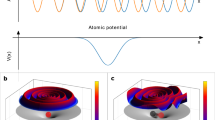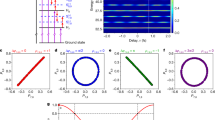Abstract
Experience shows that the ability to make measurements in any new time regime opens new areas of science. Currently, experimental probes for the attosecond time regime (10-18–10-15 s) are being established. The leading approach is the generation of attosecond optical pulses by ionizing atoms with intense laser pulses. This nonlinear process leads to the production of high harmonics during collisions between electrons and the ionized atoms. The underlying mechanism implies control of energetic electrons with attosecond precision. We propose that the electrons themselves can be exploited for ultrafast measurements. We use a ‘molecular clock’, based on a vibrational wave packet in H2+ to show that distinct bunches of electrons appear during electron–ion collisions with high current densities, and durations of about 1 femtosecond (10-15 s). Furthermore, we use the molecular clock to study the dynamics of non-sequential double ionization.
This is a preview of subscription content, access via your institution
Access options
Subscribe to this journal
Receive 51 print issues and online access
$199.00 per year
only $3.90 per issue
Buy this article
- Purchase on Springer Link
- Instant access to full article PDF
Prices may be subject to local taxes which are calculated during checkout







Similar content being viewed by others
References
Corkum, P. B., Ivanov, M. Yu. & Burnett, N. H. Sub-femtosecond pulses. Opt. Lett. 19, 1870–1872 (1994)
Drescher, M. et al. X-ray pulses approaching the attosecond frontier. Science 291, 1923–1927 (2001)
Hentschel, M. et al. Attosecond metrology. Nature 414, 509–513 (2001)
Antoine, P., L'Huillier, A. & Lewenstein, M. Attosecond pulse trains using high-order harmonics. Phys. Rev. Lett. 77, 1234–1237 (1996)
Paul, P. M. et al. Observation of a train of attosecond pulses from high harmonic generation. Science 292, 1689–1692 (2001)
Papadogiannis, N. A., Witzel, B., Kalpouzous, C. & Charalambidis, D. Observation of attosecond light localization in higher order harmonic generation. Phys. Rev. Lett. 83, 4289–4292 (1999)
Corkum, P. B. A plasma perspective on strong field multiphoton ionization. Phys. Rev. Lett. 71, 1994–1997 (1993)
Fittinghoff, D. N., Bolton, P. R., Chang, B. & Kulander, K. C. Observation of nonsequential double ionization of helium with optical tunneling. Phys. Rev. Lett. 69, 2642–2645 (1992)
Weber, Th. et al. Correlated electron emission in multiphoton double ionization. Nature 405, 658–661 (2000)
Bhardwaj, V. R., Rayner, D. M., Villeneuve, D. M. & Corkum, P. B. Quantum interference effects in double ionization and fragmentation of C6H6 . Phys. Rev. Lett. 87, 253003-1–253003-4 (2001)
Walker, B. et al. Precision measurement of strong field double ionization of helium. Phys. Rev. Lett. 73, 1227–1230 (1994)
Dietrich, P., Burnett, N. H., Ivanov, M. Yu. & Corkum, P. B. High harmonic generation and correlated two electron multiphoton ionization with elliptically polarized light. Phys. Rev. A 50, 3585–3588 (1994)
Yudin, G. L. & Ivanov, M. Yu. Physics of correlated double ionization of atoms in intense laser fields: Quasistatic tunneling limit. Phys. Rev. A 63, 033404-1–033404-14 (2001); erratum Phys. Rev. A 64, 019902 (2001).
Trump, C., Rottke, H. & Sandner, W. Strong-field photoionization of vibrational ground-state H2+ and D2+ molecules. Phys. Rev. A 60, 3924–2928 (1999)
Staudte, A. et al. Observation of a nearly isotropic, high energy Coulomb explosion group in the fragmentation of D2 by short laser pulses. Phys. Rev. A 65, 020703-1–02070-4 (2002)
Sakai, H. et al. Non-sequential double ionization of D2 molecules with intense 20 fs pulses. Phys. Rev. Lett. (submitted)
Constant, E., Stapelfeldt, H. & Corkum, P. B. Observation of enhanced ionization of molecular ions in intense laser fields. Phys. Rev. Lett. 76, 4140–4143 (1996)
Muth-Böhm, J., Becker, A. & Faisal, F. H. M. Suppressed molecular ionization for a class of diatomics in intense femtosecond laser fields. Phys. Rev. Lett. 85, 2280–2283 (2000)
Ellert, Ch. & Corkum, P. B. Disentangling molecular alignment and enhanced ionization in intense laser fields. Phys. Rev. A 59, R3170–R3173 (1999)
Hankin, S., Villeneuve, D. M., Corkum, P. B. & Rayner, D. M. Nonlinear ionization of organic molecules in high intensity laser fields. Phys. Rev. Lett. 84, 5082–5085 (2000)
Zavriyev, A., Bucksbaum, P. H., Muller, H. G. & Schumacher, D. W. Ionization and dissociation in H2 in intense laser fields at 1.064 μm, 532 nm and 355 nm. Phys. Rev. A 42, R5500–R5513 (1990)
Zavriyev, A., Bucksbaum, P. H., Squier, J. & Salin, F. Light-induced vibrational states in H2+ and D2+ in intense laser fields. Phys. Rev. Lett. 70, 1077–1080 (1993)
Seideman, T., Ivanov, M. Yu. & Corkum, P. B. The role of electron localization in intense field molecular ionization. Phys. Rev. Lett. 75, 2819–2822 (1995)
Zuo, T. & Bandrauk, A. D. Charge-resonance-enhanced ionization of diatomic molecular ions by intense lasers. Phys Rev. A 52, R2511–R2514 (1995)
Delone, N. B. & Krainov, V. P. Energy and angular electron spectra for the tunnel ionization of atoms by strong low-frequency radiation. J. Opt. Soc. Am. B 8, 1207–1212 (1991)
Peek, J. M. Inelastic scattering of electrons by the hydrogen molecular ion. Phys. Rev. 134, A877–A883 (1964)
Ammosov, M. V., Delone, N. B. & Krainov, V. P. Tunnel ionization of complex atoms and of atomic ions in an alternating electromagnetic field. Zh. Eksp. Teor. Fiz. 91, 2008–2013 (1986); Sov. Phys. JETP 64, 1191–1194 (1989).
Keldysh, L. V. Ionization in the field of a strong electromagnetic wave. J. Exp. Theor. Phys. 47, 1945–1957 (1964)
Dietrich, P., Ivanov, M. Yu., Ilkov, F. & Corkum, P. B. Two-electron dissociative ionization of H2 and D2 in infrared fields. Phys. Rev. Lett. 77, 4150–4153 (1996)
Macklin, J. J., Kmetic, J. D. & Gordon, C. L. High-order harmonic generation using intense femtosecond pulses. Phys. Rev. Lett. 70, 766–769 (1993)
Bartels, R. et al. Shaped-pulse optimization of coherent emission of high-harmonic soft X-rays. Nature 406, 164–166 (2000)
Mohideen, U. et al. High intensity above-threshold ionization of He. Phys. Rev. Lett. 71, 509–512 (1993)
Paulus, G. G., Nicklich, W., Xu, H., Lambropoulos, P. & Walther, H. Plateau in above threshold ionization spectra. Phys. Rev. Lett. 72, 2851–2854 (1994)
Feuerstein, B. et al. Separation of recollision mechanisms in nonsequential strong field double ionization of Ar: The role of excitation tunneling. Phys. Rev. Lett. 87, 043003–043007 (2001)
Becker, A. et al. Laser-induced inner shell vacancies in double ionized argon. J. Phys. B 33, L547–L552 (2000)
Bhardwaj, V. R. et al. Few cycle dynamics of multiphoton double-ionization. Phys. Rev. Lett. 86, 3522–3525 (2001)
Rischel, C. et al. Femtosecond time-resolved X-ray diffraction from laser-heated organic films. Nature 390, 490–492 (1997)
Ihee, H. et al. Direct imaging of transient molecular structures with ultrafast diffraction. Science 291, 458–462 (2001)
Ivanov, M. Yu., Corkum, P. B., Zuo, T. & Bandrauk, A. D. Routes to control of intense-field atomic polarizability. Phys. Rev. Lett. 74, 2933–2937 (1995)
Neutze, R. et al. Potential for biomolecular imaging with femtosecond X-ray pulses. Nature 406, 752–757 (2000)
Acknowledgements
F.L. acknowledges financial support from Canada's Natural Science and Engineering Research Council, the Canadian Institute for Photonics Innovation and Quebec's Fonds pour la Formation des Chercheurs et l'Aide à la Recherche.
Author information
Authors and Affiliations
Corresponding author
Ethics declarations
Competing interests
The authors declare that they have no competing financial interests.
Rights and permissions
About this article
Cite this article
Niikura, H., Légaré, F., Hasbani, R. et al. Sub-laser-cycle electron pulses for probing molecular dynamics. Nature 417, 917–922 (2002). https://doi.org/10.1038/nature00787
Received:
Accepted:
Issue Date:
DOI: https://doi.org/10.1038/nature00787
This article is cited by
-
Directly imaging excited state-resolved transient structures of water induced by valence and inner-shell ionisation
Nature Communications (2023)
-
Attosecond field emission
Nature (2023)
-
Entanglement of orbital angular momentum in non-sequential double ionization
Nature Communications (2022)
-
Picosecond pulse-shaping for strong three-dimensional field-free alignment of generic asymmetric-top molecules
Nature Communications (2022)
-
Recollision of excited electron in below-threshold nonsequential double ionization
Communications Physics (2022)
Comments
By submitting a comment you agree to abide by our Terms and Community Guidelines. If you find something abusive or that does not comply with our terms or guidelines please flag it as inappropriate.



